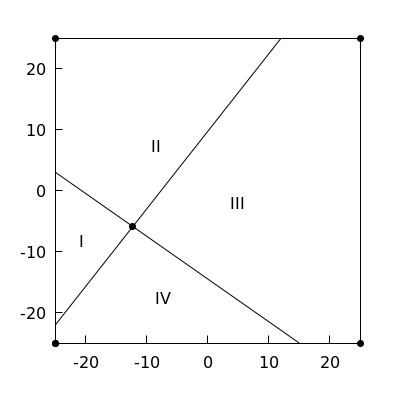Linear Inequalities: Estimations
 Multiple linear inequalities with two unknowns
Multiple linear inequalities with two unknowns
If we are to deal with several linear inequalities in two variables, it is important to first determine the set of nodes for which one of the inequalties is satisfied by an equation. Because here there is a possibility that the sign of the equation will turn.
The two lines given by the equations #-47\cdot x+37\cdot y-361=0# and #-28\cdot x-40\cdot y-580=0# divide the plane into four areas, indicated in the figure below as I, II, III and IV.

Which area is the solution of the following inequalities?
\[-47\cdot x+37\cdot y-361\lt0, \quad -28\cdot x-40\cdot y-580\gt0 \]

Which area is the solution of the following inequalities?
\[-47\cdot x+37\cdot y-361\lt0, \quad -28\cdot x-40\cdot y-580\gt0 \]
IV
After all, the node #\rv{ -25 ,-25 }# is in this area and the values of #-47\cdot x+37\cdot y-361# and #-28\cdot x-40\cdot y-580# in this node have the signs #-,+#. Consequently area IV satisfies the given inequality.
This answer can be found as follows: Node #\rv{-25,-10}# is in field I. The values of #-47\cdot x+37\cdot y-361# and #-28\cdot x-40\cdot y-580# at this node have signs #+,+#. Consequently #-47\cdot x+37\cdot y-361 \gt 0# and #-28\cdot x-40\cdot y-580 \gt0# apply in area I. If we move from this node to a node in area II, then the sign of the second inequality turns. If we move from there to area III, the sign of the first inequality turns, and both signs are turned. Finally, if we move from area III to area IV, the sign of the first inequality turns.
After all, the node #\rv{ -25 ,-25 }# is in this area and the values of #-47\cdot x+37\cdot y-361# and #-28\cdot x-40\cdot y-580# in this node have the signs #-,+#. Consequently area IV satisfies the given inequality.
This answer can be found as follows: Node #\rv{-25,-10}# is in field I. The values of #-47\cdot x+37\cdot y-361# and #-28\cdot x-40\cdot y-580# at this node have signs #+,+#. Consequently #-47\cdot x+37\cdot y-361 \gt 0# and #-28\cdot x-40\cdot y-580 \gt0# apply in area I. If we move from this node to a node in area II, then the sign of the second inequality turns. If we move from there to area III, the sign of the first inequality turns, and both signs are turned. Finally, if we move from area III to area IV, the sign of the first inequality turns.
Unlock full access


Teacher access
Request a demo account. We will help you get started with our digital learning environment.
Student access
Is your university not a partner?
Get access to our courses via Pass Your Math independent of your university. See pricing and more.
Or visit omptest.org if jou are taking an OMPT exam.
Or visit omptest.org if jou are taking an OMPT exam.



